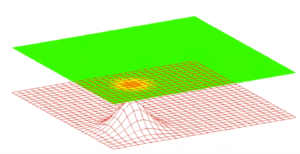Write4U
Valued Senior Member
IMO, that is an incorrect interpretation. The wave function collapse is postponed until it is collapsed by any obstacle that gets in its way.The opposing view posits that the "collapse of the wavefunction" is actually postponed until a conscious observer (e.g. a human being) makes an observation that requires such collapse.
Or until a photon strikes a plate and the photon's wavefunction collapses without anybody being present to observe this physical phenomenon. In that case, the plate is the observer and the wave function collapse is a result of the "observer effect".
Collapse of the Wave Function

The red mesh graphs the wave function of the electron. The green film represents, perhaps, a fluorescent screen. Upon detection by the fluorescent screen, the electron creates a tiny flash at a single point (yellow/orange dot).
Wave function collapse is transformation from a wave to a dot (particle). [Image source: stills from Fermilab video by Dr. Don Lincoln, “Quantum Field Theory” (in the public domain) Jan. 14, 2016;
http://www.quantumphysicslady.org/glossary/wave-function/
Last edited:
